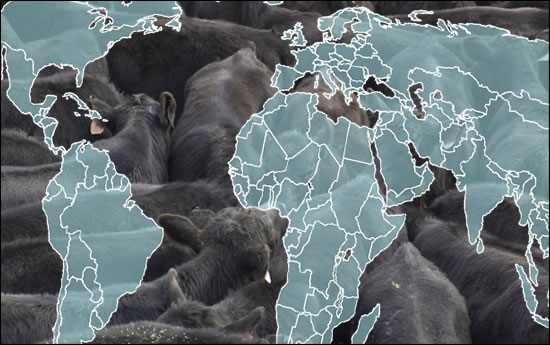
Exports Key to Beef Demand
Feeders focus on the high-quality beef that leads to brighter future.
Opportunities hide within every challenge, but beef producers can find them through analysis and planning. That was part of the take-home message at the Feeding Quality Forums Nov. 10 in South Sioux City, Neb., and Nov. 12 in Garden City, Kan.
"While domestic demand struggles, tremendous economic growth in Asia points to market potential for high-quality U.S. beef," said Dan Basse, president of the Chicago-based AgResource Co., who reprised his 2007 role as lead speaker.
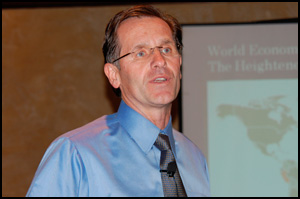
Dan Basse
The fourth annual sessions were sponsored by Pfizer Animal Health, Certified Angus Beef LLC (CAB), Feedlot magazine and Land O' Lakes Purina Feed LLC. More than 150 cattle feeders and allied professionals attended.
Beef exports represent just 7% of production, compared to pork and poultry each around 19%, Basse told them. "If U.S. beef could get that export share up to 14%, it could add $9 to $13 per hundredweight (cwt.) to cattle prices."
He suggested devoting some beef checkoff funds to building global demand. "You will need to broaden your base to generate more income and finance feed purchases in the volatile grain markets," Basse said. In the short term, demand from a recovering ethanol industry will help support an upward trend in corn prices, he added.
Mark McCully, CAB assistant vice president for supply, pointed out reasons for the recent increase in beef quality grades and highlighted the greater demand for Certified Angus Beef ® (CAB®) brand product that makes it a more rewarding and stable target than simply USDA Choice.
One measure of that demand can be seen in CAB international sales. At 10% of the company's 663 million pounds (lb.) in 2009, the ratio outpaces exports of all U.S. beef.
McCully agreed that exports hold a key to the future and noted there are few obstacles to greater supply.
"We keep finding more areas where the high-quality beef target coincides with making a profit," he said. "Producers just have to understand their own cost-value relationships that govern the purchase of feeder calves, use of technology and marketing strategies."
Genomics, or DNA marker-assisted selection of cattle, holds greater promise than adding more quality and profit potential, according to Mark Allan and Kent Andersen of Pfizer Animal Genetics.
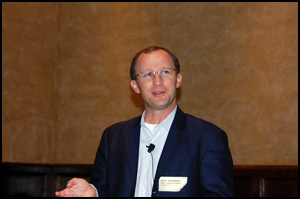
Kent Andersen
The charted markers for various traits have increased from just seven in 2004 to 54,000 today. That lets seedstock producers make decisions earlier to focus on promising lines, and plans for "marker-assisted management" will open this world to commercial cow-calf, stocker and feedlot operators, Allan and Andersen said.
Making the most of genetic potential requires focused nutrition, said Ron Scott, director of beef research for Purina Mills. He reviewed data on health and weather factors relating to performance and grade before settling into a discussion of feeding strategies.
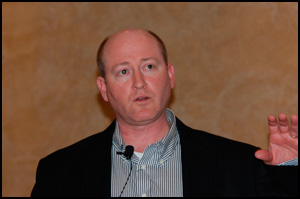
Ron Scott
The ideal balance of grains, vitamins and minerals optimizes beef quality and producer profitability. Scott presented details on industry research into distillers' byproducts and the most effective feeding levels, generally from 12% to 25%.
However, finishing diets can only fill the marbling cells determined much earlier in life. Recent research has concluded that nutritional marbling starts with fetal programming, especially in the third trimester, Scott said.
"It's based on the concept of epigenics, that the environment can cause genes to behave differently," he explained. "Studies of Holocaust survivors and their offspring prove such changes are permanent and can be passed on to future generations."
Beef cows are "the most nutritionally challenged" of livestock, seemingly by design. "We plan for them to lose weight during the winter," Scott noted, countering, "What if we cared for the cow herd like we do pregnant women?"
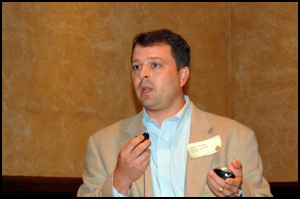
Alex Avery
In a closing presentation Alex Avery, director of research for the Hudson Institute, suggested "the tide is about to turn" in both the real and figurative "Food Wars."
Fear of hunger has fueled war for centuries, but Avery focused on the war of ideas about how food should be produced, considering that demand for it will more than double in the next 40 years. It could triple if living standards keep trending higher.
All that added demand won't come just from the growth in population, which should peak at 8.25 billion in 2050, but mainly from growth in disposable income in Asia, he said.
Echoing comments from Basse, Avery said the beef industry should not look to U.S. demand for its future base, because domestic demand for meat has stagnated to the point of "social debates that elevate myth over science."
Among the myths he works to dispel are global warming, organic utopia and the supposed unsustainable nature of large-scale farming.
"Corn-fed beef and dairy are the most planet-friendly products we can have," Avery said. "Unfortunately, some research is ignored by mainstream media and even government organizations. Pandering to perceptions justifies their budgets."
Author of "The Truth About Organic Foods," Avery challenged producers to engage the media by adding "planet-friendly" claims to all packaged fresh beef. "That will force them to face facts, even though it's a debate they don't want to have," he said.
The event was covered by BeefCast, and audio versions of the presentations
are available at
http://www.beefcast.com/2009-certified-angus-beef-feeding-quality-forum.
E-mail info@certifiedangusbeef.com for print or other details.
Audio interview with Dan Basse: (1.2Mb .wma file) or (4.8Mb .mp3 file)
Comment on this article.
[Click here to go to the top of the page.]







